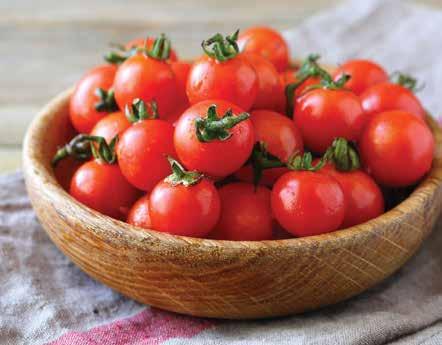
2 minute read
PLANTS ON YOUR PLATE Tomatoes
American urban markets and today is grown world-wide, where the temperate seasons allow. California, Florida, and Georgia lead tomato production in the U.S.
Tomatoes are rich in vitamin C, potassium, magnesium, and fiber. They are also one of the richest sources of lycopene, a phytonutrient that shows great promise in cancer prevention. It is worth noting that the amount of lycopene increases when tomatoes are cooked, as in a sauce.
Whether cooked or fresh, there are numerous ways to enjoy tomatoes. This salad recipe is great as a quick meal and can be personalized with any of your favorite vegetables. It also gives a nod to the Mediterranean region who first accepted tomatoes.
Mediterranean Bowl
MAKES 1 SERVING
SALAD INGREDIENTS
1/3 cup cooked brown rice
1 cup fresh spinach, roughly chopped
½ cup diced cucumber
As I visit with gardening friends or farmers market shoppers, I often hear that people are anxiously awaiting the tomatoes. America’s most popular home garden plant happens to be my favorite (and most successful) crop as well. It doesn’t matter if it is fresh from the garden or prepared into a favorite sauce or salsa, the versatility of the tomato makes it easy to understand why it is America’s favorite.
Tomatoes belong to the Solanaceae family, more commonly known as the nightshade family. Other members of the Solanaceae family include peppers, potatoes, tomatillos, eggplant, and even tobacco. For centuries, the association with the nightshade family coupled with the strong scent given off by the plant, led to the myth that tomatoes were truly poisonous. Long before it was considered fit to eat, it was grown only as an ornamental garden plant, sometimes called “love apple.”
Tomatoes are native to the Andes of Peru, where they first grew in the wild as a bright red, marble- sized, cherry-type tomato. Gradually, they would spread throughout South America and north into Central America but then the trail goes cold until Christopher Columbus’ travels to and from the ‘new world,’ which would eventually land the fruit in Spain in the mid16th century. Over the next several decades, different cultivars spread through Spain, France and Italy and became a widely accepted food in the Mediterranean region. As the tomato varieties spread north and east through Europe, they were not as widely accepted among the English and German and were often thought to be poisonous.
As the colonies established in the United States, the tomato became less feared. One of the earliest notable growers of tomatoes was Thomas Jefferson, who was a remarkably progressive Virginia farmer as well as a statesman, who grew them in the late 1780s. By the early 1800s, tomatoes had become a common enhancement in the Creole gumbos and jambalayas of Southern cooking. By 1850, the tomato had made its way into most
DENISE SULLIVAN Nutrition Ninja
½ cup cherry tomatoes, sliced in half
½ cup garbanzo beans, drained and rinsed
VINAIGRETTE INGREDIENTS
1 Tablespoon lemon juice
1 Tablespoon olive juice
1 teaspoon dried oregano
Salt and pepper
DIRECTIONS
• Wash hands and work surfaces with soap and water.
• Measure cooked brown rice and place into a medium size bowl.
• Wash and rinse spinach, cucumber, and cherry tomatoes. Chop or slice vegetables to your preference. Place on top of brown rice.
• Drain and rinse a can of garbanzo beans. Place ½ cup on top of brown rice and vegetable mixture.
• In a small bowl, combine vinaigrette ingredients. Whisk together with a fork. Drizzle all over brown rice, vegetables, and beans.
• Toss to combine. Add lemon slices as garnish if desired.
NUTRITION INFORMATION
Calories: 277, Total Fat: 16g, Saturated Fat: 2g, Sodium: 150mg, Carbohydrates: 31g, Fiber: 6g, Protein: 7g
Recipe adapted from medinsteadofmeds.com, analyzed by verywellfit.com.
Denise Sullivan (@MUExtJacksonCo) is a Nutrition and Health Education Specialist for MU Extension in the Urban West Region, serving Jackson and Platte Counties. For research based nutrition and food safety information and programs, call 816-482-5850 or visit https://extension2.missouri.edu/.








